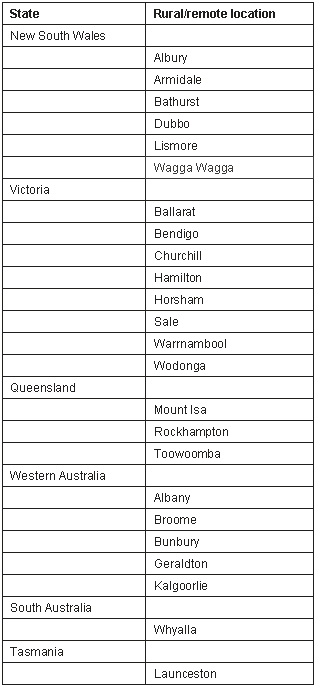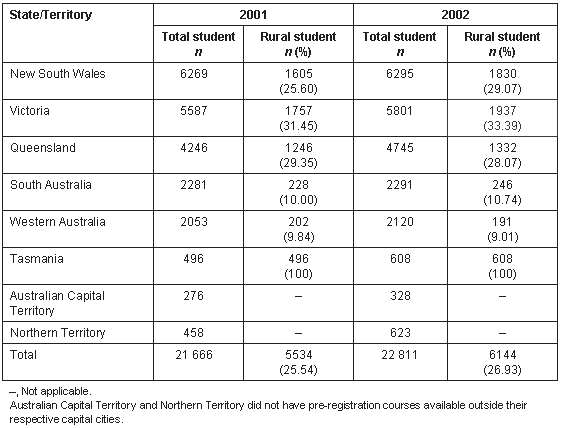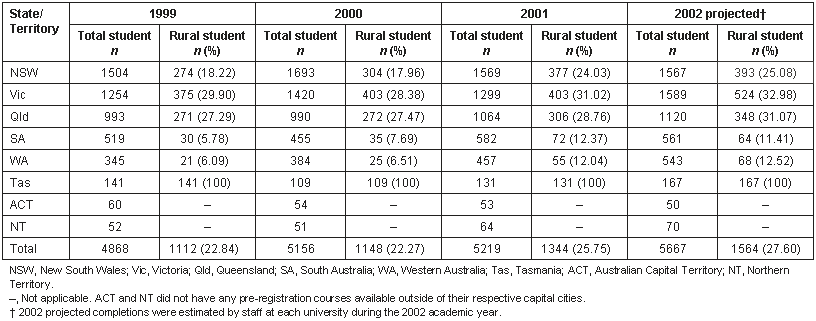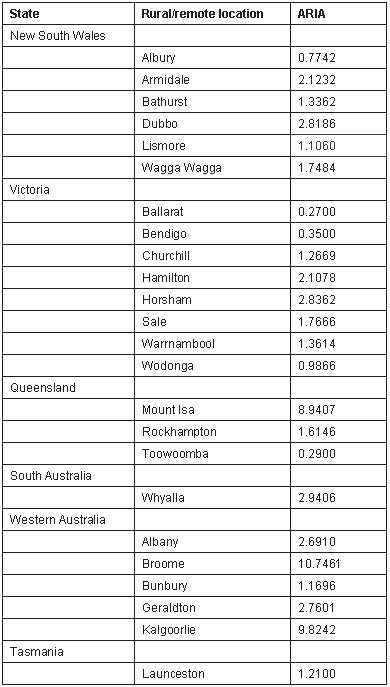There is much evidence to indicate a shortage of nurses in Australia1 and internationally2,3. Nurse shortages have resulted in many government studies examining issues related to nurse recruitment and retention, and the initiation of programs to improve recruitment and retention of nurses4-7. In Australia, the professional nursing workforce consists of two major components: Registered Nurses (RNs) (Division 1 RNs in Victoria), and Enrolled Nurses (ENs) (Division 2 RNs in Victoria). The focus of this study was the education of potential new RNs. The aims were to provide a longitudinal profile of the number of domestic students studying and completing undergraduate pre-registration nursing courses in Australia, with particular emphasis on identifying those at rural and remote university campuses, and to compare results across States and Territories.
Registered nurse shortage in Australia
The extent of the RN shortage in Australia has been investigated by the Australian Institute of Health and Welfare (AIHW)1, which reported that between 1993 and 1999, the number of RNs (full-time equivalent) in the Australian workforce per 100 000 people fell from 1074 to 1018, while the number of acute and psychiatric hospital admissions alone increased by approximately 700 000. There is evidence that in rural and remote locations, the problems associated with the shortage of nurses may be more pronounced than in metropolitan regions8,9.
More than one-third of Australians live in areas outside the major metropolitan regions, that is, in areas considered rural and remote. The rural and remote population is spread across regional centres, small rural towns and isolated farming and social communities. As distance inland increases, there is a corresponding decrease in population. The provision of health services, which are currently determined mainly on a population-based formula, also tends to be reduced as distance from areas of high population density increases.
Research published by the AIHW10 further supports the increased extent of the nurse shortage in rural and remote areas in recent years. In examining the number and distribution of health workers across Australia, the AIHW found that although there had been an overall increase in the size of the health workforce between 1996 and 2001, as the remoteness of an area increased, the number of health workers decreased. For instance, in 2001, the major Australian capital cities had between 1008 and 3005 health workers per 100 000 people, compared with remote areas, which had between 796 and 1498 health workers per 100 000 people. While these results were not specific to nurses, RNs and ENs made up more than half of the total health workforce. When these data are viewed with the AIHW nurse labour force statistics1, the combined results further imply that the reduction in the number of full-time equivalent nurses over the past 10 years has had a substantial impact in rural and remote areas.
Other evidence suggests that among the professional nursing workforce (RNs and ENs), the proportion of RNs working in rural and remote locations is considerably lower than the proportion working in metropolitan location. For instance, the AIHW reported that in 1999, approximately 83% of nurses in capital cities were RNs, but that this dropped to between 65% and 75% in smaller rural and remote areas1.
Education to increase the rural and remote RN workforce
One method of increasing the number of RNs in the workforce is to increase the intake of students into university undergraduate pre-registration nursing courses. However, this alone may not improve the situation in rural and remote areas because it has been found that only a small percentage of new nursing graduates enter practice in rural and remote areas11. There is some evidence, though, to suggest that providing education to students with familial or partner associations within rural and remote areas may result in an increased number of new graduate RNs taking positions in these areas12-15. Similarly, providing opportunities for nursing students to undertake supported placements in rural and remote settings during their undergraduate education may also be associated with increases of graduate RNs in rural and remote locations16.
To attract more students from rural and remote areas, many universities now offer pre-registration nursing courses at rural and remote campuses. There have also been recent State and Federal government funding initiatives to encourage students from rural and remote locations to undertake undergraduate pre-registration nurse education17, including the undergraduate scheme of the Australian Government's Remote and Rural Nurse Scholarship Programmes, funded through the Department of Health and Ageing. However, two important difficulties have been associated with accurately measuring rural and remote nursing student numbers. The first difficulty is defining what constitutes a rural or remote location, and the second is accurately measuring the number of nursing students enrolled in and completing tertiary pre-registration education. An aim of this study was to investigate these difficulties.
Defining rural and remote locations
Defining and categorising what constitutes rural and remote locations required investigation of classification systems of rurality and remoteness. There have been many classification systems developed (reference 11 provides a literature review pertaining to rural and remote classification for health research)11. The current Australian Bureau of Statistics (ABS) standard geographic classification of remoteness is the Accessibility/Remoteness Index of Australia (ARIA)18. The ARIA provides an index of remoteness scale based on geographic location and access to a range of services. The ARIA provides classifications for five different levels of remoteness. Unfortunately, the ARIA does not provide a classification of 'rural' and, as noted by Francis et al.11, there has been some argument that the former ABS classification (Rural, Remote and Metropolitan Areas classification [RRMA]) may be more appropriate for health research.
The RRMA classification19 uses populations in Statistical Local Areas (SLA) and the distance from the centre of the SLA to the nearest population centres in four different groupings as the basis of geographic classification. The RRMA has two main categories, metropolitan and non-metropolitan areas, which are further divided into seven sub-categories. The RRMA category of non-metropolitan areas occurs for locations that are not State or Territory capital cities and that have an urban centre of population of less than 100 000 people. Any location fitting this definition is therefore designated as either a rural or remote location. The RRMA was used to classify campus locations in the current study.
Accurately measuring tertiary student and nurse numbers
Prior to the current study in 2001, two major types of data were reported by the Federal Government on a regular basis to inform workforce planning for nurses, including nurse education policy. However, both types of data have been found to have reliability difficulties (reference 20 provides a discussion)20. The first type of data is collected annually by the Department of Education, Science and Training (DEST) from individual universities to provide information on tertiary nursing student numbers. As Ogle et al.20 stated, difficulties with this data-set included the amalgamation of pre-registration and post-registration nursing student numbers, possible confusion over the counting of actual student numbers as opposed to full-time equivalent student numbers, and the provision of aggregated data by universities that was not campus specific. These difficulties suggest that the data may not accurately reflect the number of potential new nurses for the workforce, and that the data do not always allow delineation of campus location by State or Territory (for universities with multi-State campuses) and campus location.
The second type of data are reported by the AIHW, which conducts a voluntary nursing labour force survey every 2 years in conjunction with the annual renewal of nurse registrations1,10. Included with this data is information on the number of nurse registrations by geographic employment location. However, as the AIHW and others have noted, difficulties with this data-set include estimates based on incomplete information, possible double counting of nurses with multi-State registrations, and possible omission of new RNs whose initial registration had occurred in the 12 months prior to data collection1,20,21.
Overall, these data inconsistencies and reliability difficulties indicate that a thorough understanding of the RN shortage may require more accurate workforce and undergraduate education information, particularly in relation to the situation in rural and remote Australia.
Aims of this study
The primary aim of this study was to provide a longitudinal profile of the number of domestic students studying and completing undergraduate pre-registration nursing courses in Australia. A comparison of rural and remote student numbers with total nursing student numbers, including students currently enrolled and completing courses, was undertaken at both a State/Territory and national level.
Method
This study drew upon data from two projects undertaken as part of the National Review of Nursing Education (NRNE) 200220,22. Data on undergraduate pre-registration nursing student numbers were collected via the completion of electronic survey instruments by staff at all Australian educational institutions offering undergraduate pre-registration nursing education programs in 2001 and 2002. A similar three-stage process was used for each year.
Stage One
In Stage One, university websites were searched to map all undergraduate pre-registration nursing education programs available at each university. Course profiles were confirmed through telephone contact with respondents from each university campus and later validated as part of the survey process. Ethical clearance to proceed with the project was obtained from the Deakin University Ethics Committee.
Stage Two
Stage Two involved the development of an electronic survey instrument. The instrument was designed to capture the number of enrolled undergraduate pre-registration nursing students, the number of students who had completed undergraduate pre-registration courses in the previous year(s), and the number of students expected to complete undergraduate pre-registration courses in the year the survey was distributed. In order to provide useful information to inform workforce planning, Australian domestic students were differentiated from international students. Domestic students were defined as students who were Australian citizens and/or students who permanently resided in Australia. International students were defined as students who were not Australian citizens and/or did not permanently reside in Australia and would therefore be unlikely to add to the Australian workforce. Information on undergraduate pre-registration students was gathered for 2001 and 2002, and student completion data were requested for 1999, 2000 and 2001. Data on projected completions were requested for 2002.
Emails were sent to the heads of division of nursing at each educational institution. These emails outlined the nature of the study, requested the institute's participation and asked heads to nominate appropriate staff members to whom surveys could be forwarded electronically for completion. The staff members were usually course coordinators. Surveys for each university campus were then forwarded to the nominated person, who was asked to complete and return the survey(s).
Stage Three
Returned surveys were checked for missing data and/or discrepancies. Follow-up contact was made with some institutions seeking clarification of data. Data were analysed and frequencies calculated using SPSS, vers. 11 (SPPS Inc; Chicago, IL, USA).
Results
Response rate
All surveys were returned, which provided a 100% response rate.
Rural and remote campus classification
All campus locations offering undergraduate pre-registration nursing courses were classified as either a metropolitan campus (capital city or urban centre of population >100 000) or a rural and remote campus based on the adjusted RRMA classification. Classification was made using the estimated resident populations on 31 December 2001. All campus locations classified as rural and remote are presented by State or Territory (Table 1).
Table 1: Rural, Remote and Metropolitan Areas classification of rural and remote campus locations by State/Territory based on 2001 population estimates

The Australian Capital Territory and the Northern Territory did not have any campus locations classified as rural and remote using the adjusted RRMA classification. This was because undergraduate pre-registration nursing courses were only offered at their respective capital cities. Victoria had the greatest number of rural and remote campus locations offering undergraduate pre-registration nursing courses, followed by New South Wales and Western Australia. Interestingly, the cities of Cairns and Townsville in Queensland, both of which had undergraduate pre-registration nursing courses available, were not classified as rural or remote locations because of their population size, even though they are far distant from the Queensland capital.
Pre-registration nursing student enrolments in 2001 and 2002
Frequencies were calculated for the total number of domestic students enrolled in undergraduate pre-registration nursing courses in 2001 and 2002 and, from that total, the frequencies and percentage of students enrolled at campuses in rural and remote locations. Results by State are presented (Table 2).
Table 2: 2001 and 2002 total, and rural/remote, domestic undergraduate pre-registration nursing students by State/Territory

In 2001, there were almost 21 700 domestic pre-registration undergraduate nursing students enrolled at campuses across Australia and approximately one-quarter of these were enrolled at rural and remote campuses. From 2001 to 2002, there was an increase of over 1100 (5.28%) in the total number of domestic students enrolled in undergraduate pre-registration nursing courses in Australia and an increase of over 600 (11.02%) in the number of these enrolled at rural and remote campuses. Similarly to 2001, in 2002 there were approximately one-quarter of students enrolled at campuses in rural and remote locations. Overall, the percentage of students enrolled at rural and remote campus locations for 2001 and 2002 was approaching the Australian population distribution average of approximately one-third living outside of major metropolitan centres. Increases in 2002 for the number of total students and the number of rural and remote students were found for each of the States except Western Australia, where there was a small decrease in the number of domestic undergraduate pre-registration nursing students at rural and remote campus locations. However, the State/Territory comparisons indicated that the distribution of students at rural and remote locations were not uniform across Australia.
Apart from Tasmania, where all students must complete their first 2 years of pre-registration study in the rural setting of Launceston, Victoria had the highest percentage of domestic undergraduate pre-registration nursing students enrolled in rural and remote campuses for both years, followed closely by Queensland and New South Wales. New South Wales and Victoria, the two most populous States, accounted for just over 50% of the total Australian pre-registration nursing students for both years. New South Wales had the largest percentage increase in students at rural and remote campus locations from 2001 to 2002 (approximately 3.5%). While this increase was small, it is almost twice the increase found in Victoria, and compares to a small percentage decrease in Queensland. In contrast to the approximately 30% of students at rural and remote campus locations in Victoria, New South Wales and Queensland, South Australia and Western Australia had approximately 10% of their pre-registration students enrolled at rural and remote campuses, percentage figures that were similar in 2001 and 2002.
Overall, these results suggest that the percentage of domestic pre-registration nursing students enrolled at rural and remote campuses was quite close to the percentage of the Australian population living outside of metropolitan settings. The results also suggest that there has been an increase in the relative number of students enrolled at rural and remote campuses. However, the differences among States/Territories suggest that the distribution of these students in rural and remote campuses was not uniform across Australia.
Pre-registration nursing student course completions 1999-2002
Frequencies were calculated for the total number of domestic undergraduate pre-registration nursing students who completed courses in 1999, 2000 and 2001, and who were projected to complete in 2002. Projected completions were used for 2002 because the second survey was completed before the end of the 2002 academic year. Frequencies were also calculated for the number of students completing these courses at rural and remote campus locations for each of these years and the percentage this represented of total student completions for each year. The results are available (Table 3).
Table 3: 1999-2002 total, and rural/remote, domestic undergraduate pre-registration nursing student completions by State/Territory

Between 1999 and the 2002 projected estimate, the total number of pre-registration nursing students completing courses increased by almost 800 (16.41%), and the number of course completions by students enrolled at rural and remote campuses increased by over 450 (37.18%). The largest overall yearly increases in total student completions were found from 1999 to 2000 (5.92%) and from 2001 to 2002 (projected completions increased by 8.58%). The largest overall yearly increases in rural and remote campus completions were from 2000 to 2001 (17.07%) and from 2001 to 2002 (projected completions increased by 16.37%). However, these increases were not uniform across States/Territories. For instance, total student completions in New South Wales, Victoria and the Australian Capital Territory fell between 2000 and 2001. In comparison, rural and remote student completions in South Australia and Western Australia more than doubled from 2000 to 2001, while in South Australia there was also a decrease in rural student completions between 2001 and 2002 (projected). Overall, the percentage of students completing courses while enrolled at rural and remote campuses increased by over 40% between 1999 and the 2002 projections.
Apart from Tasmania, where all completing students were initially enrolled in a rural location, Victoria had the highest percentage of course completions by students from rural and remote campuses (averaging approximately 30% of completions each year), followed by Queensland (which averaged approximately 28.5%) and New South Wales (which averaged approximately 21.5%). In contrast, the percentage of rural and remote campus student completions in South Australia and Western Australia ranged between approximately 5.5% and 12.5%, less than half of the percentage of rural and remote completions reported in Victoria and Queensland.
Discussion
While authors of previous studies have attempted to capture nursing student numbers in Australia, in the present study the authors attempted to improve the accuracy of data collection by only including students who were representative of the new and potentially new Australian RN workforce. Counting only domestic undergraduate pre-registration nursing students enabled the elimination of post-registration students from the numbers provided. Also, by having student numbers reported by individual course coordinators, it was possible to count actual students rather than full-time equivalent students.
Importantly, from the perspective of RNs working in rural and remote locations, the increase in undergraduate pre-registration student enrolments and completions at rural and remote campus locations suggests that the potential new RN workforce familiar with a rural and remote lifestyle increased at a faster rate than the Australian average. Based on the findings of Courtney et al.16, it could be argued that pre-registration nursing students who have completed courses at rural and remote campuses may be more likely to enter the RN workforce in rural and remote areas. However, there may be some areas of concern for education and workforce planners in States and Territories that are providing a smaller percentage of their undergraduate pre-registration nursing student positions in rural and remote areas.
There appear to be two main reasons for the increased number of undergraduate pre-registration nursing students across rural and remote Australia. First, the increased number of university campuses located in rural and remote regions in recent years is making it easier for rural and remote students to enter study at these locations, rather than having to travel to metropolitan or regional campuses. Second, government initiatives aimed towards providing financial encouragement to students from rural and remote areas to undertake nursing studies may be assisting more rural and remote students to contemplate a professional nursing career as an RN.
While the current study provided some evidence that there may be an increasing number of potential RNs being educated in rural and remote locations, there are several areas that require further investigation, to confirm the likelihood of this increase in potential supply to the rural and remote RN workforce eventuating. One of these areas is the number of undergraduate pre-registration nursing students studying at rural and remote campus locations who have familial ties with rural and remote communities. This may be especially important at campus locations within several hours of large metropolitan centres where students from the metropolitan centres, without familial ties with the rural/remote community, may be attracted because of easier entrance requirements or a cheaper cost of living compared with the metropolitan centres. It is possible that many such students could return to the metropolitan centre at the completion of their course. Future research could investigate the beginning work practices of these students compared with students from rural and remote area backgrounds, to establish whether this is the case.
Further investigation is needed to corroborate the findings of Courtney et al.16, and to determine the extent to which increases in the number of domestic pre-registration nursing students at rural and remote campuses translate into later increases in the number of rural and remote nurses. Given the large amount of resources being applied to increase nursing student numbers at rural and remote campuses, research in this area is vital. For instance, one factor that may limit the number of nursing graduates from rural and remote campuses who enter the workforce at these locations is that graduate year programs are only offered at larger hospitals, many of which are located in metropolitan centres. This means that many nursing graduates from rural and remote campuses and communities may have little option but to accept their initial position of nursing employment in a metropolitan centre. This may decrease the likelihood that they will return to a rural and remote setting for professional practice.
One final point for discussion is how health and other researchers are going to define rural and remote areas in the future. It is apparent that how rural and remote areas are classified does make a difference, and that future research will benefit from clarity in relation to this definition, especially with the ABS' recent move to utilise the ARIA classification system of remoteness. Because this classification system does not include a grouping of 'rural', it may be difficult to determine which specific locations could be considered rural. A preliminary investigation was undertaken for the centres classified in the current study as rural and remote using the RRMA. ARIA values were drawn from data calculated by the ABS based on the 1996 census population and statistical subdivisions23. Where there was more than one SLA for a location, the city or central SLA with the lowest ARIA value was taken. Results are provided (Table 4).
Table 4: Rural, Remote and Metropolitan Area classification of rural and remote campus locations (based on 2001 population estimates) and their Accessibility/Remoteness Index of Australia (ARIA) values (using 1996 census population and Statistical Local Areas)

ARIA scores of less than 3.51 can be classified as either 'Highly accessible' (ARIA values of 0-1.84) or 'Accessible' (ARIA values of >1.84-3.51). Most of the rural and remote locations from the current study would therefore have been classified as either highly accessible or accessible, with only three locations having an ARIA value greater than 3.51 (the cut-off for rating in the three less accessible ARIA categories). Interestingly, Townsville and Cairns, in Queensland, were not classified as rural or remote using the RRMA. Both cities have urban populations that are greater than 100 000, yet both had higher ARIA indexes by virtue of their distance from capital cities than many of the rural and remote locations listed in Table 1 (Townsville (city) SLA, ARIA = 3.0000; Cairns (city) SLA, ARIA = 3.0000). Because both of these cities have undergraduate pre-registration nursing courses, it seems that they would have been included in the analysis if the ARIA classification system was used. This would have increased the percentage of rural and remote students in the current study, particularly in the Queensland analyses. Therefore, any research or studies collecting health data across rural and remote areas needs to be mindful of the type of classification used so that comparisons with other data are valid.
Conclusion
The present study has provided a longitudinal profile of the number of domestic undergraduate pre-registration nursing students enrolled in 2001 and 2002, the number completing courses in 1999-2001, and the number projected to have completed in 2002. In particular, it provided an accurate national profile of undergraduate nursing students from rural and remote campuses. In the context of the Australian RN shortage, this study found a trend towards an increasing number of students enrolled in undergraduate pre-registration nursing courses, especially at rural and remote campuses, and an increasing number of course completions.
An increase in student numbers is vital to providing an increased supply of RNs to the workforce. However, it is important that further work be undertaken to determine whether the supply of new RNs is sufficient to meet the requirements of the workforce, particularly in rural and remote regions.
References
1. Australian Institute of Health and Welfare. Nursing labour force 2001. (National Labour Force Series no. 26). AIHW cat. no. HWL 26. Canberra, ACT: AIHW, 2003.
2. United States Department of Health and Human Services. Projected supply, demand, and shortages of registered nurses: 2000 - 2020 [monograph on the internet]. Health Resources and Services Administration, Bureau of Health Professions, National Center for Health Workforce Analysis; 2002 July [cited 2004 Jan 11]. Online (no date). Available from: http://bhpr.hrsa.gov./healthworkforce/reports/rnproject/default.htm (Accessed 15 September 2003).
3. Irwin J. Europe in crisis... falling numbers of entrants to nursing courses, and qualified nurses leaving the profession because of poor pay, workload and inflexible working practices. Nursing Standard 2000; 15(11): 26-27.
4. Queensland Health. Ministerial Taskforce - Nursing Recruitment and Retention. Brisbane, Qld, Australia: Queeensland Health, 1999.
5. Victorian Government Department of Human Services, Policy and Strategic Projects Division. Nurse Recruitment and Retention committee: Final Report. Melbourne, Vic, Australia: VGDHS, 2001.
6. Tasmanian Department of Health and Human Services, Principal Nurse Advisor's Office, Strategic Development. Final Report of the Tasmanian Nurse Workforce Planning Project. Tasmania (Australia): TDHHS, 2001.
7. New South Wales Health Department, Nursing Branch, Nursing and Health Services Research Consortium. New South Wales Nursing Workforce Research Project. Sydney, NSW, Australia: NSWHD, 2000.
8. Handley A. Setting the scene: rural nursing in Australia. Royal College of Nursing, Australia and the Association for Australian Rural Nurses, Monograph Series Vol 1. Canberra, ACT: RCN, 1998.
9. Hegney D, McCarthy A. Job satisfaction and nurses in rural Australia. Journal of Nursing Administration 2000; 30: 347-350.
10. Australian Institute of Health and Welfare. Nursing labour force 2002. AIHW cat. no. HWL 29 (National Labour Force Series no. 29). Canberra, ACT: AIHW, 2003.
11. Francis K, Bowman S, Redgrave M. Knowledge and skills required by rural nurses to meet the challenges of a changing work environment in the 21st century: a review of the literature. National Review of Nursing Education 2002: Literature Reviews. Canberra, ACT: Department of Education, Science and Training; 2002. Epub 2001, Dec.
12. Dunkin J, Juhl N, Stratton T. Why rural practice? Nursing Management 1996; 27(12): 26-28.
13. Huntley B. Factors influencing recruitment and retention: why RNs work in rural and remote area hospitals. Australian Journal of Advanced Nursing 1995; 12(2): 14-19.
14. Hegney D. The differences of rural nursing practice. In: Proceedings, 5th National Conference of the Association for Australian Rural Nurses, 'Rural Nursing: Celebrating Diversity'. 1-3 February 1997, Ballarat, Vic, Australia. Canberra, ACT: Association for Australian Rural Nurses, 1997.
15. Hegney D, McCarthy A, Rogers-Clark C, Gorman D. Why nurses are attracted to rural and remote practice. Australian Journal of Rural Health 2002; 10: 178-186.
16. Courtney M, Edwards H, Smith S, Finlayson K. The impact of rural clinical placement on student nurses' employment intentions. Collegian 2002; 9(1): 12-18.
17. Queensland Health. Rural Scholarship Scheme. Information Kit. Brisbane, Qld, Australia: GoPrint, 2001.
18. Commonwealth Department of Health and Aged Care. Measuring remoteness: accessibility/remoteness index of Australia (ARIA) (Revised edition). Occasional papers: New Series Number 14. Canberra, ACT: CDHAC, 2001.
19. Commonwealth Department of Primary Industries and Energy, Department of Human Services and Health. Rural, Remote and Metropolitan Areas Classification. 1991 Census Edition. Canberra, ACT: DPIE, 1994.
20. Ogle K, Bethune E, Nugent P, Walker A. Nursing education and graduates: Profiles for 1999, and 2000, with projections for 2001, Commonwealth Department of Education, Science and Training. Canberra, ACT, Australia: Department of Education, Science and Training (Online) 2001. Available: http://www.dest.gov.au/archive/highered/eippubs/eip01_13/default.htm (Accessed 11 January 2004).
21. Johnson D, Preston B. An overview of issues in nursing education, Commonwealth Department of Education, Science and Training, Evaluations and Investigations Programme, Higher Education Division. Canberra, ACT, Australia: Department of Education, Science and Training, 2001.
22. Ogle K, Bethune E, Nugent P, Walker A, Wellman D. National Review of Nursing Education, Nursing education and graduates - part 2: profiles for 2001 with projections for 2002, Commonwealth Department of Education, Science and Training. Canberra, ACT, Australia: Department of Education, Science and Training. (Online) 2002. Available: http://www.dest.gov.au/archive/highered/nursing/pubs/nursing_ed_part2/default.htm (Accessed 11 January 2004).
23. Commonwealth Department of Health and Aged Care. ARIA scores and categories of ABS Statistical Local Areas (1996 Census boundaries), Commonwealth Department of Health and Aged Care. Canberra, ACT, Australia: Commonwealth Department of Health and Aged Care (Online) updated 13 June 2001. Available: http://www.health.gov.au/ari/aria.htm#db (Accessed 2004 January).
Abstract
Introduction: There is much evidence to indicate a shortage of Registered Nurses (RNs) in Australia and to suggest that the shortage may be more pronounced in rural and remote locations. Attracting RNs to work in rural and remote areas may not be as simple as increasing the intake of students into university undergraduate pre-registration nursing courses. There is some evidence indicating that student nurses may be more likely to enter the nursing workforce in rural and remote locations if they have existing associations with rural and remote areas and/or their undergraduate education provides opportunities to undertake supported placements in rural and remote settings. Two important difficulties have been associated with measuring outcomes in relation to rural and remote pre-registration nursing students. One is defining what constitutes a rural or remote location and the other is suspect data on the number of nursing students enrolled in, and completing, nursing courses. The aims of this study were to provide a longitudinal profile of the number of domestic students studying and completing undergraduate pre-registration nursing courses in Australia, with a particular emphasis on identifying those at rural and remote university campuses, and to compare results across States and Territories.
Method: This study presents the combined findings from two investigative reports. Data on undergraduate pre-registration nursing student numbers were collected via electronic survey instruments completed by staff at all Australian educational institutions offering undergraduate pre-registration nursing education programs in 2001 and 2002. Australian domestic students were the focus of this study. Data included the total number of domestic students enrolled in undergraduate pre-registration nursing courses in 2001 and 2002, the number of domestic students who successfully completed courses in 1999, 2000 and 2001, and estimates for the number expected to complete in 2002. Surveys were sent to course coordinators or other staff nominated by heads of divisions of nursing at each institution.
Results: There was a 100% response rate. Twenty-four rural and remote campus locations were identified using an adjusted form of the Rural, Remote and Metropolitan Areas (RRMA) classification system. The Australian Capital Territory and the Northern Territory did not have any rural or remote campus locations. In contrast, undergraduate pre-registration nursing in Tasmania was offered at a rural campus only (for the first 2 years). From 2001 to 2002, there was an increase of just over 5% in the total number of domestic students enrolled in undergraduate pre-registration nursing courses in Australia (2002 total = 22 811 students). Rural and remote location students accounted for slightly more than 25% of these students in 2001, and almost 27% in 2002. The States Victoria, New South Wales and Queensland had the highest percentage of students enrolled at rural and remote campus locations, greater than the Australian average for both years. In contrast, South Australia and Western Australia had less than 11% of students enrolled at rural and remote campus locations for each year. Total undergraduate pre-registration course completions increased by approximately 16% across Australia between 1999 (n = 4868) and 2002 (n = 5667), although for 2002, the figure was projected. Of these total course completions, the percentage of students completing at rural and remote campus locations increased from almost 23% to nearly 28% during the same period. Of the States/Territories with both metropolitan and rural/remote campus locations, only Victoria and Queensland had more than 25% of their total student completions consisting of students enrolled at rural and remote campus locations for each year. In contrast, South Australia and Western Australia had approximately 6% of student completions consisting of students enrolled at rural and remote campus locations in 1999, increasing to approximately 12% projected for 2002.
Conclusion: In this study, the authors attempted to improve the accuracy of data collection in relation to the number of domestic undergraduate pre-registration nursing students in Australia, which is representative of the potentially new Australian domestic RN workforce. There was a trend towards an increasing number of students being enrolled in undergraduate pre-registration nursing courses, and also toward an increasing number of course completions. From the perspective of the rural and remote RN workforce, the percentage of students enrolled and completing courses at rural and remote campus locations was found to be increasing. However, there may be some areas of concern for education and workforce planners in States and Territories that are providing a smaller percentage of their undergraduate pre-registration nursing courses in rural and remote areas. Several study limitations are discussed and suggestions made for future research.
Key words: Australia, course completions, course enrolments, nurse education, registered nurses.
You might also be interested in:
2011 - Student opinions on a rural placement program in New South Wales, Australia




